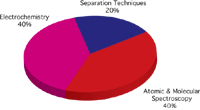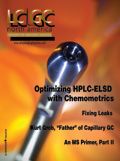Water Analysis and Testing
Water is one of the most abundant compounds found in nature. An estimated 1.4 billion cubic kilometers of water exists on Earth and it covers 70% of our planets surface. Water is also a key element to life and makes up 70% of the fat-free mass of the human body. It is not surprising then that water is used, to at least some extent, in nearly all industries, and to quite a significant extent in most. The need to analyze water for contaminants, as well as its life-supporting characteristics, is nearly as wide.
Water is one of the most abundant compounds found in nature. An estimated 1.4 billion cubic kilometers of water exists on Earth and it covers 70% of our planet's surface. Water is also a key element to life and makes up 70% of the fat-free mass of the human body. It is not surprising then that water is used, to at least some extent, in nearly all industries, and to quite a significant extent in most. The need to analyze water for contaminants, as well as its life-supporting characteristics, is nearly as wide.

2007 water analysis market demand by Technique.
When it comes to industrial process water, almost anything present in the water at varying levels can present a potential problem in some industries. One of the biggest examples is the semiconductor and electronics industry, which generally use deionized (DI) water. This water is free of practically anything down to the parts-per-billion (ppb) level because of the scale and resulting sensitivity of modern electronic devices to contaminants. The pharmaceutical industry is another major industrial user of water. Although most final dosage forms of drugs are in solid form, water is a key tool in the manufacturing process of most cases.
Such a diverse range of water usage and the resulting variation in purity requirements, have led to the development of a large and incredibly varied market for water analysis instrumentation. In 2007, the worldwide demand for laboratory separations techniques like HPLC, ion chromatography (IC) and gas chromatography (GC) was $800 million for environmental analyses. Moreover, separation techniques represent about a fifth of the water testing market. Overall annual growth has been somewhat modest during the last few years, but demand for individual methods, configurations, and in various geographical regions vary considerably.
The foregoing data was extracted and adapted from SDi's Market Analysis and Perspective report on the Water Testing & Analysis Market: Lab & Process – Wastewater to Ultrapure Water. For more information, contact Glenn Cudiamat, VP of Research Services, Strategic Directions International, Inc., 6242 Westchester Parkway, Suite 100, Los Angeles, CA 90045, (310) 641-4982, fax: (310) 641-8851, email: cudiamat@strategic-directions.com.

Regulatory Deadlines and Supply Chain Challenges Take Center Stage in Nitrosamine Discussion
April 10th 2025During an LCGC International peer exchange, Aloka Srinivasan, Mayank Bhanti, and Amber Burch discussed the regulatory deadlines and supply chain challenges that come with nitrosamine analysis.
Top Execs from Agilent, Waters, and Bruker Take the Stage at J.P. Morgan Healthcare Conference
January 16th 2025The 43rd Annual Healthcare J.P. Morgan Healthcare Conference kicked off in San Francisco earlier this week. Here’s what top executives from Agilent, Bruker, and Waters, discussed during the event.

.png&w=3840&q=75)

.png&w=3840&q=75)



.png&w=3840&q=75)



.png&w=3840&q=75)





